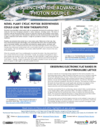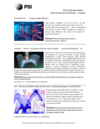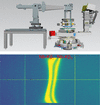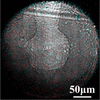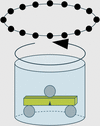issue contents
May 2025 issue
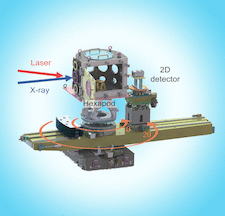
Cover illustration: A multi-functional chamber for resonant X-ray scattering experiments in the tender X-ray regime (2–5 keV) at the Femtosecond X-ray Scattering endstation at PAL-XFEL (see Park, Kim, Park, Yun, Jeong, Park, Kim, Choi, Eom, Jang, Kim, Lee, Park, Kim and Chun, pages 539–547). The chamber is integrated into a diffractometer, enabling a variety of X-ray diffraction and scattering geometries. Its optical and X-ray windows are specifically designed for optical laser pump and X-ray probe experiments, which facilitates femtosecond time-resolved X-ray studies.
facility information
research papers
Open  access
access
 access
accessA new X-ray spectrometer for high photon energies based on Laue analyzer crystals is presented. Its performance in terms of energy resolution and efficiency is discussed. Niobium Kα and Kβ emission data collected with this Laue spectrometer are given.
Open  access
access
 access
accessThe first implementation of an operando transmission X-ray microscopy to study laser melting at X-ray free-electron lasers is described. The instrument uses a novel pump–probe scheme to image down to 940 nm spatial resolution with integration times <100 fs and up to 0.48 GHz frame rates to study the rapid dynamics and small-scale features in laser additive manufacturing.
Open  access
access
 access
accessA portable and compact nanofocusing system was developed for X-ray free-electron lasers with the ability to generate Zn Kα lasers with the world's highest photon energies on amplified spontaneous emission.
Open  access
access
 access
accessA multi-functional chamber at the Femtosecond X-ray Scattering endstation of the PAL-XFEL is introduced, developed for time-resolved resonant X-ray scattering experiments in the tender X-ray regime (2–5 keV).
Open  access
access
 access
accessThe significant advancements in biological research enabled by the Linac Coherent Light Source (LCLS) are explored. By offering ultra-bright, coherent X-ray pulses with femtosecond durations, LCLS has revolutionized the study of biological molecules and their dynamic processes. Techniques such as serial femtosecond crystallography leverage these unique properties, allowing researchers to image complex biomolecular structures at atomic resolutions and in near-native conditions. The ability to perform time-resolved studies and observe real-time interactions at the molecular level provides deeper insights into mechanisms underlying biological functions. The discussions presented highlight key studies and innovations facilitated by LCLS, underlining its critical role in advancing both fundamental biological knowledge and applied sciences such as drug development.
Open  access
access
 access
accessThe Structural Biology Research Center at the High Energy Accelerator Research Organization has developed advanced systems for macromolecular crystallography, including an automated crystallization screening system, a long-wavelength crystallography beamline and an automated data-collection system.
Open  access
access
 access
accessDetails on the current status of the experimental techniques available at the ESRF–EBS and ILL research infrastructures are provided. Major contributions made by the EMBL, ESRF, ILL and IBS to the structural biology field are described, including future prospects at the EPN campus
Open  access
access
 access
accessRecent studies of the ultimate brightness limits of medium-energy synchrotron light sources at operational beam intensities are summarized, focusing on how collective effects, such as intrabeam scattering and bunch lengthening, influence beam emittance and brightness. The study identifies optimal beam and machine parameters that balance these effects to maximize brightness for user experiments.
Open  access
access
 access
accessA constant-imaging-distance fixed-included-angle grating monochromator has been designed and constructed at the X-ray test beamline at Shanghai Synchrotron Radiation Facility to expand the covered energy range of the beamline.
Open  access
access
 access
accessA machine learning (ML)-based method for beam orbit correction in circular particle accelerators is explored. Traditional correction techniques rely on the response matrix. Nonlinear elements, like those in the upcoming SLS 2.0 at the Paul Scherrer Institut, challenge the effectiveness of response-matrix-based methods. The ML approach promises to handle nonlinearities and large perturbations more efficiently. A potential limitation of ML models—dimensional changes after optimization—is also addressed, and a solution to enhance model robustness is proposed, paving the way for more reliable and efficient beam steering.
Open  access
access
 access
accessThe presented measurement using a silicon drift detector allows us to observe the photon beam center of undulator radiation without the influence of bending magnet radiation.
Open  access
access
 access
accessAvalanche photodiode detectors at synchrotron sources can now be used at much higher count rates due to improved digital signal processing.
Open  access
access
 access
accessThe OÆSE endstation at EMIL at the BESSY II synchrotron facility in Berlin allows real-time investigation of energy materials through operando X-ray absorption spectroscopy. The possibility to use soft, tender, and hard X-rays combined with versatile operando sample environments enables the study of a wide range of energy materials under relevant operation conditions.
Open  access
access
 access
accessThe BM02/D2AM beamline at the ESRF is shown to be suitable for performing X-ray photon correlation spectroscopy experiments with a flux that prevents samples' irradiation effects, features particularly suitable for polymer-based materials.
Open  access
access
 access
accessA portal to cross-search XAFS databases worldwide has been created and the unification of vocabulary and knowledge behind it are discussed.
Open  access
access
 access
accessMHz X-ray photon correlation spectroscopy with a containerless sample holder at the European XFEL is demonstrated.
Open  access
access
 access
accessA novel workflow using conditional generative adversarial networks (cGANs) to remove/suppress air artifacts in phase contrast micro-computed tomography, improving visualization and facilitating structural analysis, is described.
Open  access
access
 access
accessThe use of Noise2Inverse in low-dose in situ synchrotron micro-computed tomography experiments shows high feasibility and promise for biological tissues such as bone. With appropriate scanning parameters and experimental setup, features in bone such as lacunae volume and shape as well as mineralization can be reasonably preserved while reducing radiation dose by two to three times.
Open  access
access
 access
accessThis paper introduces high-resolution imaging using diffuse probes, which allow for lower energy deposition per unit area per unit time, by encoding Huffman-like patterns onto them, enabling a tighter impulse response. The approach, demonstrated in X-ray imaging, involves using specially fabricated masks to shape the probe and recover sharp object images through robust deconvolution.
Open  access
access
 access
accessDiscorpy, a Python package for camera calibration, provides robust tools to independently correct radial and perspective distortion of varying strengths using a single calibration image.
Open  access
access
 access
accessOptimizing phase-contrast micro-computed tomography for a given object is not trivial if the radiation is polychromatic and the object multi-material. This study demonstrates how an optimal combination of propagation distance and mean energy may be derived for such an object – an electromotor scanned on beamline BM18 at ESRF, France.
Open  access
access
 access
accessThe Extended Image Restoration (ExImRes) method has been developed to enhance the spatial resolution of Bragg coherent X-ray diffraction imaging by combining multiple lower-resolution images from the same dataset. Applied to chiral gold and platinum nanoparticles as examples, ExImRes overcomes traditional resolution limits to enable precise calculations of strain field energy and atomic deformation correlation lengths, revealing detailed lattice-scale information previously inaccessible.
beamlines
Open  access
access
 access
accessThe performance of the High Energy beamline of the Brockhouse Sector of the Canadian Light Source is described in terms of flux, bandwidth, divergence, and focus of the beam. Its uses include high energy penetrating diffraction, high pressure diffraction, and pair distribution function studies.
Open  access
access
 access
accessThe XRD2 beamline at Elettra-Sincrotrone Trieste has been in operation since 2018 and is dedicated to macromolecular crystallography for both academic and industrial research, a role partially fulfilled, before 2018, by XRD1, a general-purpose diffraction beamline. With the upcoming Elettra 2.0 upgrade, based on a six-bend enhanced achromat lattice, the synchrotron will offer a brighter, more powerful beam to address evolving challenges in crystallography.
Open  access
access
 access
accessThe history, current state and future directions of the three MX beamlines BL14.1, BL14.2 and BL14.3 of the Helmholtz-Zentrum Berlin at the BESSY II electron storage ring are described.
Open  access
access
 access
accessA comprehensive overview of the protein crystallography beamlines BioMAX and MicroMAX is given. This work introduces FragMAX, a platform for early drug discovery as well potential opportunities for protein crystallography at FemtoMAX, a beamline dedicated to ultrafast experiments.
Open  access
access
 access
accessThis work presents the design and expected performance of an Angle-Resolved Photoemission Spectroscopy (ARPES) branchline at the Shenzhen Superconducting Soft X-ray Free Electron Laser (S3FEL). The branchline employs a symmetric time-delay-compensated monochromator (TDCM) for spectral selection and pulse duration preservation. Numerical optimization using the six-dimensional K-matrix method and Fourier optics simulation shows that the TDCM can achieve a time–bandwidth product approaching the Fourier-transform limit.
Open  access
access
 access
accessA detailed description of the technical specifications of beamline P21.1 at the PETRA III storage ring is given. It serves as a reference for the beamline user community and, by giving a number of scientific examples, we hope to inspire future experiments.
computer programs
Open  access
access
 access
accessAdvanced software for X-ray spectroscopy imaging has been developed, enabling precise and rapid XANES imaging analysis. Its effectiveness has been demonstrated by mapping the Ni oxidation states in lithium-ion battery cathodes, thereby revealing their heterogeneity.
Open  access
access
 access
accessA computing framework for real-time analysis of X-ray detector data streamed directly to Python applications via the EPICS pvAccess protocol is described.
addenda and errata
Open  access
access
 access
accessA correction in the paper by Oberthür et al. [(2025). J. Synchrotron Rad. 32, 474–485] is made.

 journal menu
journal menu







